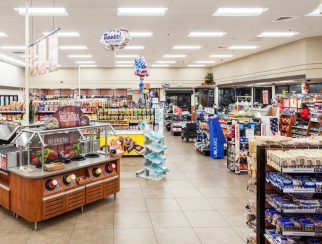This article was published in the September 2016 issue of STORES Magazine.
Slightly more than 100 facilities into a five-year upgrade to LED lighting in all of its more than 650 locations, Knoxville, Tenn.-based Pilot Flying J has realized significant energy savings as well as substantial maintenance reductions.
Pilot Flying J operates travel centers and travel plazas across North America that are open 24 hours a day, seven days a week. The company also operates 52 Goodyear Commercial Tire and Service Centers and 44 Boss Shops.
Its facilities serve more than 1.3 million customers daily; the Pilot Flying J network provides access to more than 70,000 parking spaces for trucks, 4,800 showers and more than 4,400 diesel lanes.
“LED lights have an enormous amount of room for technological growth and offer various advantages over all other forms of lighting.”
Bryan Martin
Pilot Flying J
The lighting upgrade “will generate long-term energy reductions and material maintenance savings due to avoiding ballast and lamp changeouts,” says Bryan Martin, the company’s energy manager.
Martin says that studies have shown that in locations that have 24/7 lighting requirements, consumption of kilowatt-hours between traditional fluorescent versus LED is significant.
Additionally, “LED lights have an enormous amount of room for technological growth and offer various advantages over all other forms of lighting,” he says. “Stores are brighter and inviting, and cooler-door LED lights enhance product appearance.”
Energy cost reductions
The energy-savings upgrade includes canopy lights, fixtures and area LED lighting from Cree, a market leader in providing interior and exterior LED lighting solutions.
Andrew Strickland, Cree’s vice president of petroleum lighting sales, says it’s common to realize as much as a 50 percent reduction in energy costs as well as significant maintenance reductions and rapid payback.
The transition was four years in the planning, and the installations are progressing smoothly. Upgrades are being done, sectionalized by site, in an average of three to five days.
The program is underway, with Cree LED lighting retrofits completed at nearly 100 Pilot and Flying J Travel Centers to date and plans to roll out dozens of new stores annually over the next five years.
Martin says that many factors went into switching to LED, instead of the traditional fluorescent and high-intensity discharge systems.
“LED lighting has proven to have longer life, requires less maintenance and uses significantly less energy.”
Bryan Martin
Pilot Flying J
“Our main goal is to make sure that we’re supplying each of our travel centers with the types of equipment and products that will make our guests feel comfortable when stopping at any of our locations,” he says.
In addition to providing “an improved quality of light, making sure that our interiors and exteriors are better illuminated for our guests,” Martin says, “LED lighting has proven to have longer life, requires less maintenance and uses significantly less energy.”
He says that Pilot Flying J has worked with Cree in the past as “part of our new construction and remodeling activities, and we’ve considered them a strong partner that works well with us to find solutions to our lighting needs.”
Uniformity and control
For canopy installations, Pilot Flying J is using Cree’s CPY 250 lights which use 82 to 122 watts, replacing lights that were consuming between 358 to 450 watts. Cree’s system provides “a significant reduction in energy as well as producing a more uniform and beautiful light with great color quality,” Strickland says.
Martin says the Cree systems deliver “better light that enhances customer experiences at the pump and inside our travel centers.”
Pilot Flying J is using Cree’s OSQ lights for area lights, which use 250 watts versus the 1,000-watt lights the company had been using, resulting in a 75 percent energy reduction.
The OSQ lights are designed to slip into existing fixtures, keeping “the installation process as easy as possible and costs down,” Strickland says. “It is an extremely important part of our business.”

On the inside of facilities, Pilot Flying J replaced primary ambient lights — 2x4-foot units — with Cree’s LED ZR lights. Strickland says these provide enhanced color quality and high vertical illumination in the area where the ceiling and the wall meet, eliminating shadows, reflecting light better and making merchandising presentations and graphics more vibrant. That eliminated the need for wall wash, an additional lighting product that Pilot Flying J had been using.
In total, the company went from over 120 watts in a typical florescent troffer down to 44 watts and eliminated an additional 60 to 80 watts from the wall wash lights.
Inside stores, Pilot Flying J is using small Cree flat-drop lenses that create an enhanced merchandising presentation, brightening the colors of graphics and products close to the ceiling, Strickland says.
“Switching to LED,” Martin says, “benefits Pilot Flying J now and provides us with the opportunity to continue growth in the future.”